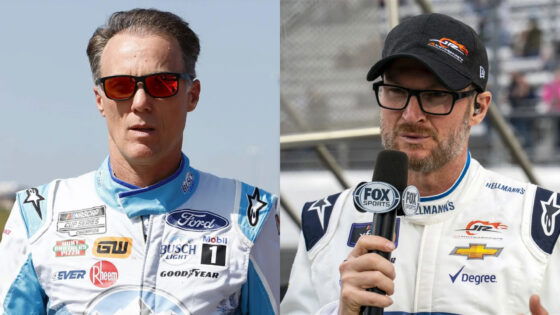When he retired in 2017, Dale Earnhardt Jr. didn’t just leave a legacy behind the wheel. Instead, he built one that still runs four-wide across America. Since its humble beginnings in 2005, JR Motorsports has grown into a powerhouse in the NASCAR Xfinity Series. They have captured three championships (2014, 2017, and 2018) and notched 58 series victories along the way. With four full-time entries and a loyal following, JRM isn’t just competing, it’s touring the country with a roster of young talents and seasoned veterans chasing the next checkered flag.
But lately, Dale Jr. can’t ignore the unsettling questions looming over the series he’s helped define. Sitting down with fellow NASCAR veteran Kevin Harvick, the 2x Xfinity Series Champion driver opened up about the parts shortage, outdated tech, and a looming shift that could change the series forever. The Xfinity Series isn’t dying, per se. But according to the two legends, its future needs to be questioned.
Xfinity Series is obsolete according to Dale Jr.
The NASCAR Xfinity Series, once a vibrant stepping stone for aspiring drivers, is now grappling with an identity crisis. Originating in 1982 as the Budweiser Late Model Sportsman Series, it evolved into a premier platform for up-and-coming talent and seasoned racers alike. However, recent developments have cast a shadow over its future.
Dale Earnhardt Jr. recently voiced concerns about the series’ viability. Speaking to Kevin Harvick on the Happy Hour podcast, he highlighted the obsolescence of parts used in Xfinity cars, stating, “The parts and pieces that we’re all using to race Trucks or Xfinity are a bit obsolete, and I wish they weren’t.” Unlike the Cup Series, which has moved to a Next Gen platform with standardized, modern components, Xfinity teams still rely on legacy parts and older technology.
For instance, the Cup Series Next-Gen car uses a newer spec chassis, an independent suspension (rear), and other exclusive features. On the other hand, the Xfinity cars retain legacy parts like a solid axle (rear) and an H-pattern transmission. Unfortunately, much of it is no longer in production.
Aug 19, 2023; Watkins Glen, New York, USA; NASCAR Xfinity Series driver Austin Hill (21) leads driver Justin Allgaier (7) during the Shriners Children’s 200 at Watkins Glen International. Mandatory Credit: Matthew O’Haren-USA TODAY Sports
Teams often source parts from a shrinking pool of suppliers, salvage used Cup equipment, or rely on small specialty shops. As these parts become harder to find, the risk of supply shortages grows, threatening the viability of the entire series. Kevin Harvick echoed Dale Jr.’s sentiment, adding, “Now you don’t have the Cup cars with everything flowing down with the parts and pieces to make the Xfinity cars more functional.”
“Everything’s kind of in a bit of a spin right now,” Dale Jr. admitted, reflecting broader uncertainty. There are even whispers in the garage that the Xfinity Series could face drastic changes, or worse, an existential crisis, if solutions aren’t found soon. Yet, there may be hope in reinvention. “I believe that the Xfinity series has to find a bit of an identity, and I think NASCAR is trying to figure out what that is,” Dale Jr. said.
But where does that reinvention begin? If NASCAR wants to preserve the legacy of its developmental series, it might have to embrace bold technological shifts. With hybrid and electric vehicle prototypes already in testing, the Xfinity Series could serve as the ideal testing bed before those innovations reach the Cup level.
Will EVs and hybrids save the NASCAR Xfinity Series?
As the NASCAR Xfinity Series faces a crossroads, the question of whether electric vehicles (EVs) and hybrids can secure its future is more urgent than ever. Dale Earnhardt Jr. recently captured the mood, saying, “They aren’t making this electric car for fun. There’s a purpose behind that.” His words reflect a growing understanding within the sport. Innovation isn’t just about keeping up with trends. It may be essential for survival!
“Don’t get me started on that,” said Kevin Harvick to Dale Jr. The 2014 Cup Series Champion has voiced his displeasure for EVs in the past, and does not want to see them anywhere in NASCAR. Harvick said in 2024, “There is no future for a NASCAR electric vehicle racing. If it does not make noise and smell like it’s burning gas, there is no freaking way.”
NASCAR’s unveiling of its first electric racecar, developed with Chevrolet, Ford, Toyota, and ABB, signals a major shift. The prototype, boasting over 1,300 horsepower and rapid acceleration, is a bold step. But it’s not destined for competition. Yet! Instead, NASCAR is using it to gauge fan interest and experiment with what the future of stock car racing might look like. Fans are already panicking with the electric car making an appearance at Team Penske’s garage. The Xfinity Series, with its legacy technology and looming parts shortages, is a logical candidate to pilot such change.
The move toward electrification and hybrid technology isn’t unique to NASCAR. Other series, like IMSA and IndyCar, are already integrating hybrids. Formula E has built an entire fan base around electric racing. However, there’s a delicate balance to strike. Many fans cherish the roar of traditional engines and the visceral experience of a race weekend. NASCAR’s leadership is aware that any transition must respect the sport’s roots while embracing innovation.
So, now the ultimate question remains. Will EVs and hybrids save the Xfinity Series? Or will they spark a new debate about what defines NASCAR racing? The answer may shape the next chapter of the sport. What do you think? Is the Xfinity Series dying, and will EVs bring new life to it? Do let us know your thoughts below!
The post Dale Earnhardt Jr. and Kevin Harvick Raise Alarms on NASCAR Xfinity’s Troubling Future Amidst Fading Equipment Supply appeared first on EssentiallySports.
